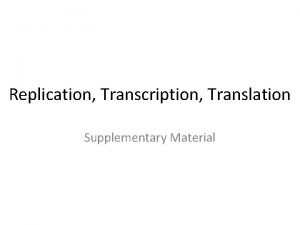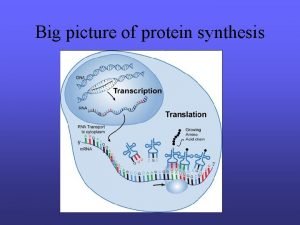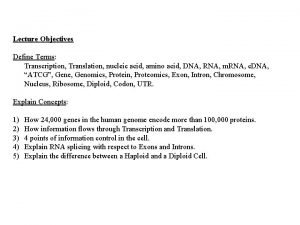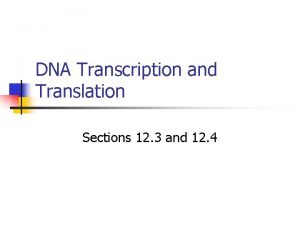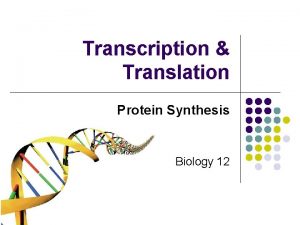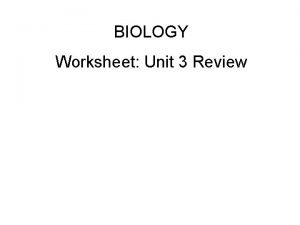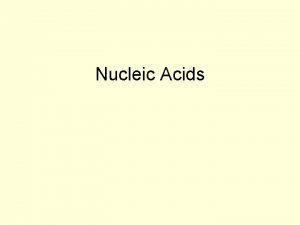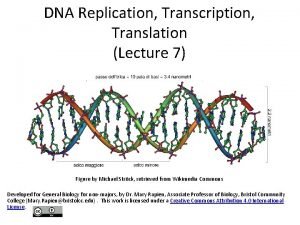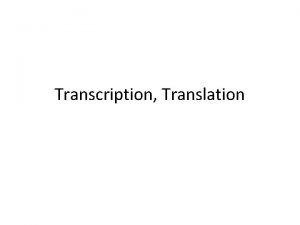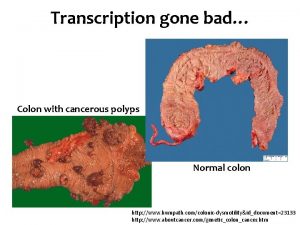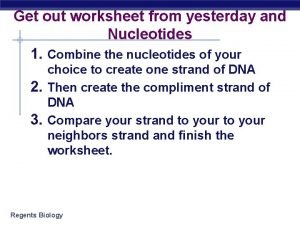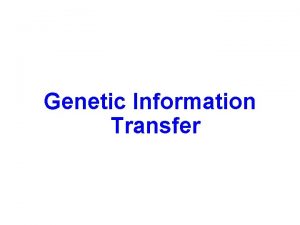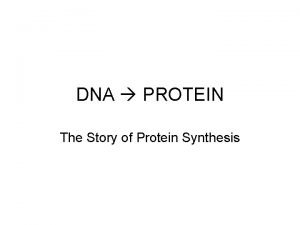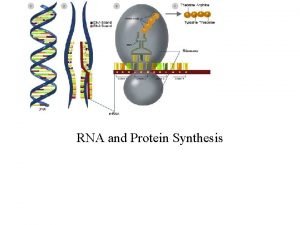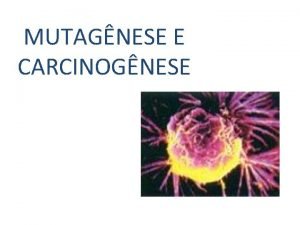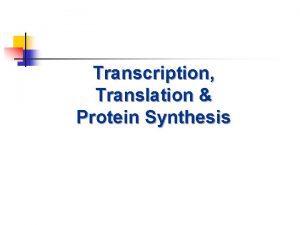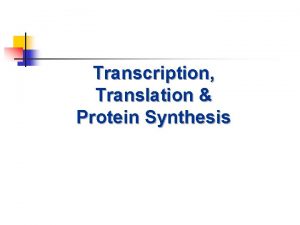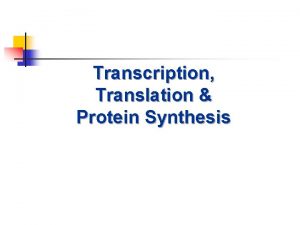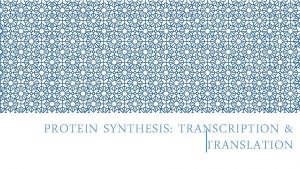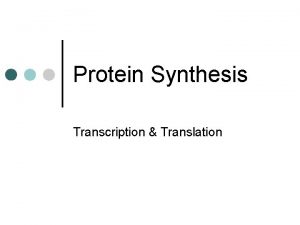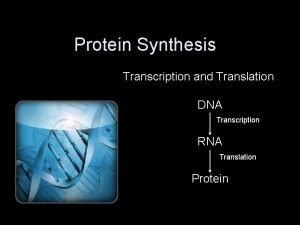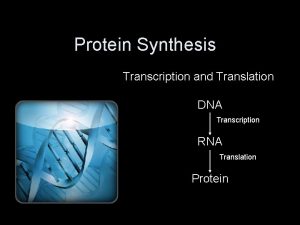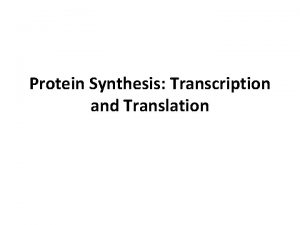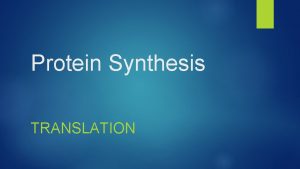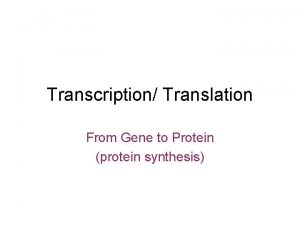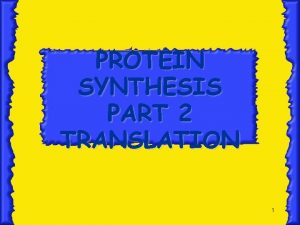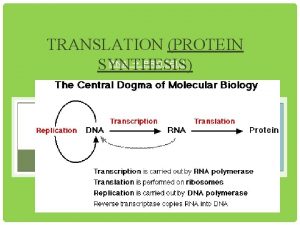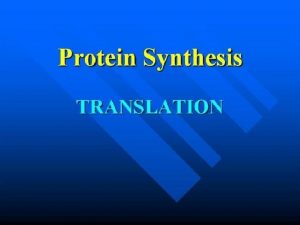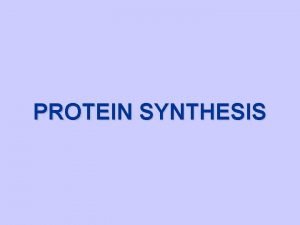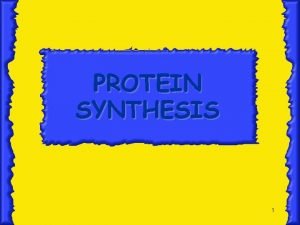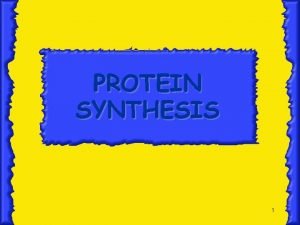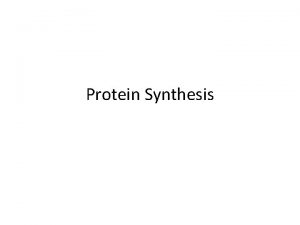PROTEIN SYNTHESIS Transcription Translation Pg 224 261 TRANSCRIPTION
























- Slides: 24

PROTEIN SYNTHESIS Transcription & Translation Pg. 224 -261

TRANSCRIPTION

CENTRAL DOGMA Defined by Crick States information flows in one direction

COMPARING DNA AND RNA DNA Sugar - deoxyribose Uses the base thymine DNA is double stranded RNA Sugar - ribose Uses the base uracil in place of thymine (U instead of T) RNA is single stranded

HOW ARE DNA AND RNA SIMILAR? 1. chain of nucleotides 2. made of phosphate group, sugar, and a nitrogen containing base RNA is a temporary copy of DNA § Used then destroyed

TRANSCRIPTION Transcription - process of copying a sequence of DNA to produce a complementary strand of RNA A gene, not an entire chromosome, is transferred to RNA

TRANSCRIPTION STEP 1 RNA polymerase recognizes transcription start site of a gene (START CODON) DNA unwinds

TRANSCRIPTION STEP 2 RNA polymerase makes a complementary strand of RNA using DNA. § Same base pairing rules with one difference (replace T with U for RNA) DNA helix zips back together

TRANSCRIPTION STEP 3 Once gene is transcribed, new RNA strand detaches

FUNCTIONS OF RNA Messenger RNA (m. RNA) – intermediate message that is translated to form a protein Ribosomal RNA (r. RNA) – forms parts of ribosomes (cell protein factories) Transfer RNA (t. RNA) – brings amino acids from the cytoplasm to a ribosome to help make the protein

TRANSCRIPTION IS SIMILAR TO… Transcription and replication are similar § Both take place in nucleus (DNA CANNOT LEAVE NUCLEUS) § Both use a large complex enzyme § Both involve base pairing § Both are regulated § Different products/functions

TRANSLATION

TRANSLATION Translation - converts, or translates, a m. RNA message into a polypeptide § One or more polypeptides make proteins

CODON Codon – three nucleotide sequence that codes for an amino acid. Amino Acid -building block of protein

STOP CODONS These signal the stop of an amino acid chain

START CODON Signals the start of translation and the amino acid methionine § This means translation always begins with methionine § Methionine can be removed later if necessary


READING FRAME The correct order in which codons are read correctly

COMMON LANGUAGE Genetic code is shared by almost all organisms Example: UUU will always code for phenylalanine – in armadillos, humans, cacti, virus, etc. Often called a universal code Suggests all organisms share a common ancestor

RIBOSOMES Ribosomes – site of protein synthesis (TRANSLATION)

t. RNA – adaptor between m. RNA and amino acids

TRANSLATION PROCESS 1 t. RNA pairs with the m. RNA codon

TRANSLATION STEP 2 Ribosome forms a peptide bond between the two amino acids

TRANSLATION STEP 3 Polypeptide continues to grow until stop codon is reached
 Translation protein synthesis
Translation protein synthesis Translation transcription
Translation transcription Transcription translation replication
Transcription translation replication Protein synthesis splicing
Protein synthesis splicing Picture of protein synthesis
Picture of protein synthesis Dna transcription and translation
Dna transcription and translation Messenger rna sequence
Messenger rna sequence Transcription or translation
Transcription or translation Transcription translation replication
Transcription translation replication Biology transcription and translation
Biology transcription and translation Translation
Translation Transcription and translation coloring
Transcription and translation coloring Translation transcription
Translation transcription Transcription translation venn diagram
Transcription translation venn diagram Rna matching
Rna matching Dna replication transcription and translation
Dna replication transcription and translation Virusmax
Virusmax Central dogma
Central dogma Protein synthesis gcse
Protein synthesis gcse Venn diagram to compare dna and rna
Venn diagram to compare dna and rna Synthesis
Synthesis Protein synthesis
Protein synthesis Rna protein synthesis
Rna protein synthesis Rna transfer
Rna transfer Teste de ames
Teste de ames


